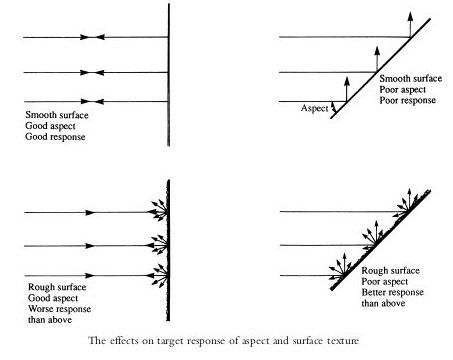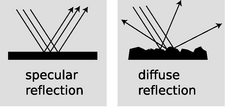I see a couple posts mentioning the bi-static configuration as the 'stealth' anti-dote.
True...Technically speaking, the bi-static radar is the greatest threat to 'stealth'...At the theoretical level at this time.
To understand what is this 'bi-static' thingie, one must understand how radar behaves upon contact in the first place.
When a signal impact a surface, the direction of reflection depends on the reflecting surface, as illustrated above. Basic geometry tells us the angle of deflection (reflection) equals the angle of incidence (impact). Nothing new here.
The concept applies at all levels of fineness, from the surface level...
...To the body level.
The vast majority of radars are mono-static, meaning a single antenna does both jobs of transmission and reception and when dealing with airborne targets, it is extremely rare than a mono-static radar will receive the full strength of a flat plate type reflection. The majority of the time, the majority of the reflected signal are of the angled type with only a very small percentage (specular) to return to source direction.
So what a bi-static system does is to station physically distinct receivers that are sufficiently far enough away from the transmitter (avoid interference) to catch that majority of reflected signal. The ideal configuration is the 90deg bi-static triangle but because the target is mobile, that ideal situation practically never exist.
Which lead us to the multi-static configuration with many receivers stationed at what is believed to be 'ideal' locations to catch passing target. Sooner or later, in a multi-static system, one of the many receivers will momentarily achieve this ideal geometry with the target. That mean the more receivers there are, the greater the odds of detecting and triangulating a 'stealth' target.
Which lead us to the often cited Kolchuga system and its supposedly 'cure' for the F-22.
First, there is no such beast as a 'passive radar'. Radar detection is a two-part process: Transmission and Reception. Without either, the concept of radar itself does not work.
What Kolchuga, Silent Sentry, and other similarly proposed systems are: passive opportunistic reflection detectors. They are either receivers only or a collection of receivers working under the guidance of a main transmitter. The word 'opportunistic' mean they rely on transmitters and transmissions that
ARE NOT UNDER CONTROL, meaning transmitters that came from TV, cellular, music radio, and even other radars for reflections off any target.
The main problem with the typical bi-static set up is that each transmitter/receiver pairing must be fully conscious of what the other is doing. The receiver must know what the transmitter is doing in terms of freq, pulse characteristics, power, and direction. Timing and coordination is crucial. In a multi-static system, it is no different because there is still a bi-static triangle for each transmitter/receiver pairing. If there are 10 receivers, there are 10 bi-static triangles.
The problem is much greater in a passive opportunistic detector because it does not have knowledge of when the TV is going off the air or how many music radio stations are in the area or how many cellular towers are there in the defended area. The receiver does not control them, does not know how many signals are in collision, thereby contaminating each other, and so on...
From combat actions to equipment failures to human errors, these could deprive a good portion of the city of electricity, thereby denying this network of passive receivers their transmitters and create coverage gaps that the enemy could pass through.
If the multi-static system have its own transmitters and power supply, the data links and synchronization of data transfer are still technical challenges. If Receiver A and B picks up reflected signals, a central authority must be available and able to correlate and verify if these signals are from true targets or a part of the EM background.
In short, the bi-static radar sounds good on paper to defeat 'stealth' but for now it is highly problematic and tactically questionable because it is not as mobile as its mono-static cousin and have too many dependencies. Forget 'Kolchuga' and 'Silent Sentry'. They are nothing more than marketing labels no different than what automobile makers give to their creations. Too many people latches onto marketing labels and give themselves and each other false understanding. The real keyword searches are 'bi-static' and 'multi-static' or variants thereof.









